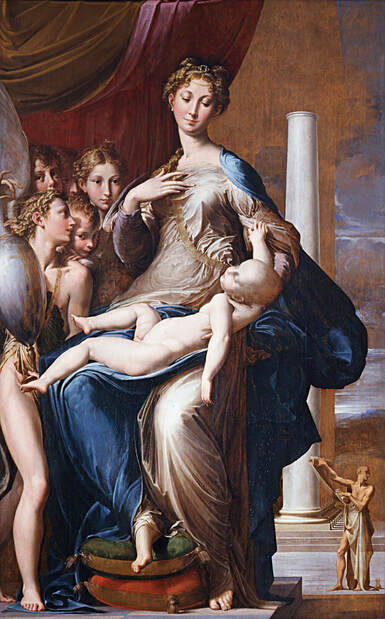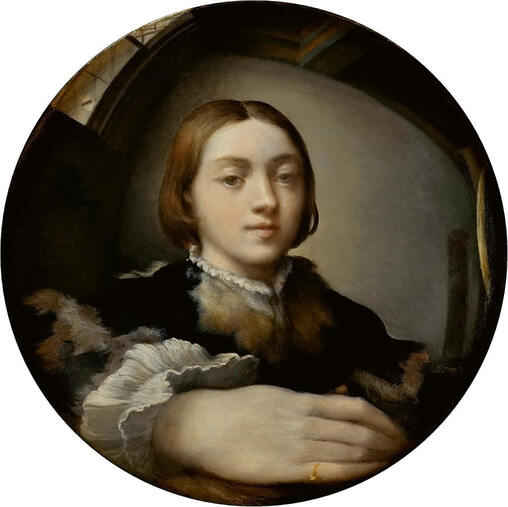|
Where? Room 74 of the Uffizi Museum
When? 1534-1540 Commissioned by? Elena Baiardi for the funerary chapel of her husband Francesco Tagliaferri in Parma What do you see? Mary is holding the Baby Jesus. Mary has a very long, swan-like, neck. Notice also the length of her fingers and shoulders, and the oversized Jesus. These extended body features are typical of Mannerism. Mary’s beautiful hair is painted in detail as well as the pearls in her hair. She has bare feet and her right foot is resting on two beautiful green and orange pillows. On the left, six (somewhat eroticized) angels are all looking at different directions. Can you identify all six angels? In the bottom right, Saint Jerome (a well-known priest born in the fourth century) is depicted as a Greek statue. On the left, you can see the angel holding a large vase with the shadow of a cross painted on it. Backstory: This painting is also known as ‘Madonna of the Long Neck’ or ‘Madonna and Child with Angels and St. Jerome’. The painting is unfinished as Parmigianino died in 1540, which adds to the mystery of the painting. Quite some people say that Jesus already appears dead in this painting, something that could fit with the purpose of the painting to appear in a funerary chapel. Symbolism: Mary is wearing a blue robe, representing her purity, virginity, and royalty. On the right, the small figure of Saint Jerome is included, which was required by the commissioner for Saint Jerome’s connection to the worship of Mary. In hymns from the medieval times, the neck of Mary was compared to an ivory tower or column, which explains the presence of the exaggerated length of Mary’s neck as well as the columns on the right. Why Mary? Mary had a symbolic role of representing the church. This representation is in line with the analogy between the long neck of Mary and the ivory columns. The columns are also an architectural reference to the church. Who is Parmigianino? Parmigianino (1503-1540) was born in Parma (where he was named after, though his real name is Girolamo Francesco Mario Mazzola). He is known for his unorthodox and Mannerist painting style. Another well-known painting of Parmigianino is his self-portrait in a convex mirror which can be found in the Kunsthistorisches Museum in Vienna. Giorgio Vasari claimed that Parmigianino was an incarnation of Raphael (they both died at age 37). He is also known for his great etchings and woodcarvings.
What is Mannerism? This painting by Parmigianino is one of the prime examples of Mannerism. This style started in around 1520 at the end of the High Renaissance and lasted until about 1580 when the Baroque movement took over. In Mannerism ideals such as proportions, balance, and ideal beauty are violated on purpose. This style leads to paintings that are asymmetric and out of balance.
Fun fact: Just like Leonardo da Vinci and Michelangelo, Parmigianino found it difficult to finish his work due to his attention to detail. Indeed, several parts of this painting are unfinished, but we have a decent idea of what he intended to paint from the many surviving preliminary drawings that he created before starting with this painting.
Interested in a copy for yourself? Poster
0 Comments
|
Categories
All
|
- Home
- Blog
-
Museums
- Alte Pinakothek
- Art Institute of Chicago
- Baltimore Museum of Art
- Barber Institute of Fine Arts
- Bargello
- Barnes Foundation
- British Museum
- Church of Sant’Anastasia
- Cleveland Museum of Art
- Courtauld Institute of Art
- Detroit Institute of Arts
- Frans Hals Museum
- Galleria Borghese
- Gallerie dell'Accademia
- Getty Museum
- Guggenheim
- Hermitage Museum
- Kunsthistorisches Museum
- Kunstmuseum Basel
- Legion of Honor Museum
- Louvre
- Mauritshuis
- Metropolitan Museum of Art
- Musee d’Orsay
- Museum of Fine Arts in Boston
- Museum of Modern Art
- National Gallery in London
- National Gallery of Art
- National Museum in Poznań
- Norton Simon Museum
- Ny Carlsberg Glyptotek
- Palace of Versailles
- Palazzo Pitti
- Palazzo Vecchio
- Petit Palais
- Philadelphia Museum of Art
- Prado
- Pushkin Museum
- Ravenna Art Museum
- Rijksmuseum
- San Diego Museum of Art
- Santa Maria delle Grazie
- St. Peter's Basilica
- Städel Museum
- Statens Museum for Kunst
- Tate Britain
- Tate Modern
- Timken Museum of Art
- Uffizi
- Vatican Museums
- Wallace Collection
-
Artists
- Altdorfer
- Anguissola
- Berlin Painter
- Bosch
- Botticelli
- Boucher
- Bronzino
- Bruegel the Elder
- Brunelleschi
- Cabanel
- Caillebotte
- Canova
- Caravaggio
- Carpeaux
- Cezanne
- Cimabue
- David
- Degas
- Delacroix
- De Maria
- Donatello
- El Greco
- Fontana
- Fra Angelico
- Fragonard
- Gauguin
- Gentileschi
- Gericault
- Gonzalez-Torres
- Goya
- Hals
- Hogarth
- Hokusai
- Ingres
- Leonardo da Vinci
- Lippi, Filippo
- Longhi, Barbara
- Lorrain
- Makovsky
- Manet
- Massys
- Matisse
- Merian
- Michelangelo
- Mochi
- Modigliani
- Monet
- Panini
- Parmigianino
- Perugino
- Picasso
- Pisanello
- Raphael
- Rembrandt
- Renoir
- Reynolds
- Rivera
- Rodin
- Rubens
- Scultori
- Seurat
- Steen
- Tintoretto
- Titian
- Toulouse-Lautrec
- Turner
- Uccello
- Van der Weyden
- Van Dyck
- Van Eyck
- Van Gogh
- Van Hemessen
- Vasari
- Velazquez
- Vermeer
- Veronese
- Vigée Le Brun
-
Locations
- Books
- About Us


